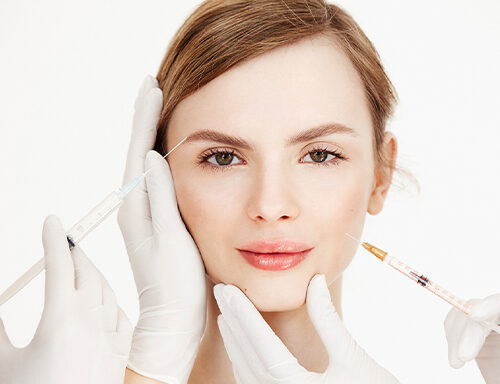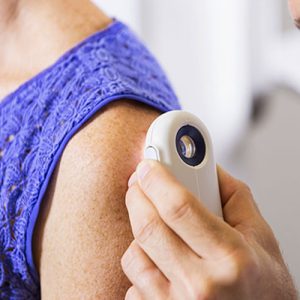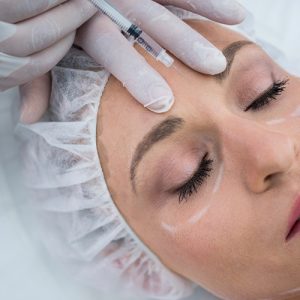Our brain sends electric messages to muscles to make them move or contract. Botox blocks these messages so the muscle doesn’t receive the contraction message. Therefore, those spasms and movements responsible for creating wrinkles are frozen or their activities are slowed significantly. Patients with over-sweating can have a temporary treatment by Botox injection. In this case, Botox is injected in the armpits, behind the knees, or the hand palms to block the spread of Acetylcholine near the sweat glands.
What Are the Botox Target Areas?
*Forehead Botox
*Glabella/frown lines
*Crow’s feet (side lines)
*Bunny lines (lateral lines of the nose)
*Mouth and teeth lines (smokers lines)
*Marionette Lines: musclesMentalis malfunction (chin)
*Platysma lines
*Eyebrows lift
*Hyperhidrosis (excessive sweating)
*Under arm
*Palmaris
*Plantaris
The number of injections is not the same for everyone.
Generally, the specialist asks the patient to frown to find the best spot for the injection.
Some specialists may even use stimulators to find the exact injection site while in some cases more experienced specialists might feel that it is not necessary.
What Happens in A Forehead Botox Session?
The doctor injects Botox into the target muscles. Most of the of Botox injection sessions are for the forehead and the outer area of the eyes. Usually, there are 1 – 3 injections in each muscle. Botox side effects are very rare but you may have a feeling of pressure, pigmentation, and burning. Normally, you can see the results in a few hours or up to three hours.
In some cases, your doctor may ask you to avoid any muscle movement in the treated area until the forehead Botox injection starts to come into effect. In addition, your doctor may ask you not to bend your neck or lay down for 4 hours after the treatment.
What Happens in the Next Weeks?
You can see the maximum results in one or two weeks. Usually, you need a re-injection every six month. It is important to know that the results fade away by time and the person notices the ability to move their forehead.
How Long Does Forehead Botox Injection Last?
Generally, the results last for three months that make your skin look smoother and improve the appearance of fine lines and wrinkles. As the Botox injections start to lose their effect, the person notices the reduction in the firmness of the injected sited. This is when you need to go for a revival session. Botox has proved to be quite effective in treating wrinkles and fine lines. Patients claim that the lines on their foreheads are vanished and their skin looked even after a treatment period.
The Risks, Side Effects, and Prohibitions for Forehead Botox
Each dose increases the effect of the previously injected dose. In long term, Botox treatment can be applied unlimitedly. However, if you are pregnant or use specific medications, you are not a good candidate for Botox treatment. The Botox effects may increase if you take special antibiotics (such as Aminoglycoside) or other medications that interfere with neurological muscle transfers. Therefore, you need to tell your doctor about every medications that you use before doing the Botox treatment. Sometimes, you may have temporary headaches, hematoma, ectropion, diplopia, bruises, and temporary ptosis of the eyelids. these symptoms fade away by time but talk to your physician if any abnormal side effect.
Are You Afraid of Botulism?
It was an old saying that you do not need to be afraid of Botulism and can try Botox injections. Truth untold, this saying is true only about the FDA licensed Botox and you need to take precaution against unauthorized ones. Additionally, cutting down on strong antibiotics such as Levaquin, Cipro, or Clindamycin can let you get better results after Botox injections. In some cases, you had better wait until you completely used the prescribed antibiotics before trying Botox. If you are on Aminoglycoside antibiotics, we recommend letting your doctor know.
*What? Type A Botulinum.
*Why? Treating eye spasm, crossed eyes, cosmetic usages, forehead Botox, fine lines and wrinkles, smiling line, frown line, crows pawns, and more.
*When? Whenever you need to, usually from your late 50s – sometimes 60s.
*Who? Plastic surgeon, dermatologist, or your doctor does it.
*Where? Doctor’s office, cosmetic clinics ran by medics.
*Cut/Scar: None
*Anesthesia: Not applicable
*Duration: 30 minutes
*Pain factor: A few headaches in the next week, irritation or at least pressure while injecting.
*Inflammation: Mild
*Bruise: Rare but possible
*After care instructions: Your doctor might ask you to frown and tighten your eyes and move your forehead upward and downward regularly to help the injection get into the right place. It’s often recommended to not lie down or bend for 4 hours afterwards. Ask your doctor for instructions after treatment.
*First checkup after the injection: Not necessary
*Second checkup after the injection: Not necessary
*Going back to work: Immediately
*Activities pace: In a few days after the injection be very careful and try to avoid moving the injection area. Yet, in some cases, the patients are instructed to frown regularly for 10 days after the injection or move the muscles of their foreheads. Again, avoid laying down or bending for 4 hours.
*Sun exposure: Avoid extreme sun exposure since it can make the bruises last longer or even cause brown spots in the injection area.
*Final result: The maximum healing and the best result becomes obvious in a week or two but there are reported case of achieving the result in three days.
*Anesthesia: Probable use but rarely
*Durability: Forehead Botox injection results usually last for almost three months. It leads to making the skin even, improving the fine lines and wrinkles in the injection sites. As the Botox starts to fade, you will notice the difference. It is time to book your next session.












